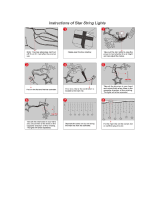
2
INTRODUCTION...........................................................................................................................................................5
WARNING .......................................................................................................................................................................5
QUICK SETUP ...............................................................................................................................................................6
ASSEMBLY.....................................................................................................................................................................9
ASSEMBLING THE NEXSTAR ...........................................................................................................................................9
Setting Up The Tripod ...............................................................................................................................................9
Adjusting the Tripod Height ....................................................................................................................................10
Attaching the NexStar to the Tripod ........................................................................................................................10
Attaching the Hand Control ....................................................................................................................................11
Adjusting the Clutches.............................................................................................................................................12
The Star Diagonal ...................................................................................................................................................12
The Eyepiece ...........................................................................................................................................................12
The Finderscope......................................................................................................................................................13
Finderscope Installation.......................................................................................................................................13
Aligning the Finderscope.....................................................................................................................................14
Powering the NexStar..............................................................................................................................................14
HAND CONTROL........................................................................................................................................................15
Hand Control Operation .........................................................................................................................................16
Alignment Procedures .............................................................................................................................................16
GPS Alignment....................................................................................................................................................17
Auto-Align ..........................................................................................................................................................18
Two Star Alignment ............................................................................................................................................19
Quick-Align.........................................................................................................................................................19
Quick-Align.........................................................................................................................................................19
EQ North / EQ South Alignment.........................................................................................................................20
NexStar Re-Alignment ........................................................................................................................................20
Object Catalog ........................................................................................................................................................21
Selecting an Object..............................................................................................................................................21
Slewing to an Object ...........................................................................................................................................21
Finding Planets .......................................................................................................................................................21
Tour Mode...............................................................................................................................................................22
Direction Buttons ....................................................................................................................................................22
Rate Button..............................................................................................................................................................22
Setup Procedures.....................................................................................................................................................23
Tracking Mode ....................................................................................................................................................23
Tracking Rate ......................................................................................................................................................23
Date/Time............................................................................................................................................................23
User Defined Objects ..........................................................................................................................................23
Get RA/DEC .......................................................................................................................................................24
Goto R.A/Dec......................................................................................................................................................24
Scope Setup Features...........................................................................................................................................24
Steup Time-Site...................................................................................................................................................24
Anti-backlash ......................................................................................................................................................24
Slew Limits .........................................................................................................................................................24
Filter Limits.........................................................................................................................................................25
Direction Buttons ................................................................................................................................................25
Goto Approach ....................................................................................................................................................25
Autoguide Rates ..................................................................................................................................................25
Cordwrap.............................................................................................................................................................25
Utility Features .......................................................................................................................................................25
GPS On/Off .........................................................................................................................................................25
Compass ..............................................................................................................................................................26
Alt Sensor............................................................................................................................................................26
Wedge Align .......................................................................................................................................................26
Periodic Error Correction ....................................................................................................................................26
Light Control .......................................................................................................................................................26
Factory Settings...................................................................................................................................................26





















